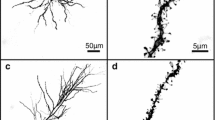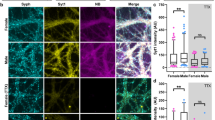Abstract
Previous work has shown that the steroid hormone estradiol facilitates the release of anticonvulsant neuropeptides from inhibitory neurons in the hippocampus to suppress seizures. Because neuropeptides are packaged in large dense core vesicles, estradiol may facilitate neuropeptide release through regulation of dense core vesicles. In the current study, we used serial section electron microscopy in the hippocampal CA1 region of adult female rats to test three hypotheses about estradiol regulation of dense core vesicles: (1) Estradiol increases the number of dense core vesicles in axonal boutons, (2) Estradiol increases the size of dense core vesicles in axonal boutons, (3) Estradiol shifts the location of dense core vesicles toward the periphery of axonal boutons, potentially lowering the threshold for neuropeptide release during seizures. We found that estradiol increases the number and size of dense core vesicles in inhibitory axonal boutons, consistent with increased neuropeptide content, but does not shift the location of dense core vesicles closer to the bouton periphery. These effects were specific to large dense core vesicles (>80 nm) in inhibitory boutons. Estradiol had no effects on small dense core vesicles or dense core vesicles in excitatory boutons. Our results indicate that estradiol suppresses seizures at least in part by increasing the potentially releasable pool of neuropeptides in the hippocampus, and that estradiol facilitation of neuropeptide release involves a mechanism other than mobilization of dense core vesicles toward sites of release.


Similar content being viewed by others
References
Acsady L, Arabadzisz D, Freund TF (1996a) Correlated morphological and neurochemical features indentify different subsets of VIP-immunoreactive interneurons in rat hippocampus. Neuroscience 73:299–315
Acsady L, Gorcs TJ, Freund TF (1996b) Different populations of VIP-immunoreactive interneurons are specialized to control pyramidal cells or interneurons in the hippocampus. Neuroscience 73:317–334
Backstrom T (1976) Epileptic seizures in women related to plasma estrogen and progesterone during the menstrual cycle. Acta Neurol Scand 54:321–347
Baraban SC, Tallent MK (2004) Interneuron diversity series: interneuronal neuropeptides–endogenous regulators of neuronal excitability. Trends Neurosci 27:135–142
Bean AJ, Zhang X, Hokfelt T (1994) Peptide secretion: what do we know? FASEB J 8:630–638
de Lanerolle NC, Gunel M, Sundaresan S, Shen MY, Brines ML, Spencer DD (1995) Vasoactive intestinal polypeptide and its receptor changes in human temporal lobe epilepsy. Brain Res 686:182–193
Feldman SC, Dreyfus CF, Lichtenstein ES (1982) Somatostatin neurons in the rodent hippocampus: an in vitro and in vivo immunocytochemical study. Neurosci Lett 33:29–34
Ferraro F, Ma X-M, Sobota JA, Eipper BA, Mains RE (2007) Kalirin/trio rho guanine nucleotide exchange factors regulate a novel step in secretory granule maturation. Mol Biol Cell 200718:4813–4825
Fiala JC, Harris KM (2001) Cylindrical diameters method for calibrating section thickness in serial electron microscopy. J Microsci 202:468–472
Grabner CP, Price SD, Lysakowski A, Cahill AL, Fox AP (2006) Regulation of large dense-core vesicle volume and neurotransmitter content mediated by adaptor protein 3. Proc Natl Acad Sci USA 103:10035–10040
Guille C, Spencer S, Cavus I, Epperson CN (2008) The role of sex steroids in catamenial epilepsy and premenstrual dysphoric disorder: implications for diagnosis and treatment. Epilepsy Behav 13:12–24
Harris KM, Marshall PE, Landis DM (1985) Ultrastructural study of cholecystokinin-immunoreactive cells and processes in area CA1 of the rat hippocampus. J Comp Neurol 233:147–158
Hart SA, Snyder MA, Smejkalova T, Woolley CS (2007) Estrogen mobilizes a subset of estrogen receptor-alpha-immunoreactive vesicles in inhibitory presynaptic boutons in hippocampal CA1. J Neurosci 27:2102–2111
Herzog AG (2008) Catamenial epilepsy: definition, prevalence pathophysiology and treatment. Seizure 17:151–159
Husum H, Mikkelsen JD, Mork A (1998) Extracellular levels of neuropeptide Y are markedly increased in the dorsal hippocampus of freely moving rats during kainic acid-induced seizures. Brain Res 781:351–354
Jinno S, Kosaka T (2003) Patterns of expression of neuropeptides in GABAergic nonprincipal neurons in the mouse hippocampus: quantitative analysis with optical disector. J Comp Neurol 461:333–349
Kaminski RM, Livingood MR, Rogawski MA (2004) Allopregnanolone analogs that positively modulate GABA receptors protect against partial seizures induced by 6-Hz electrical stimulation in mice. Epilepsia 45:864–867
Kunkel DD, Nguyen LB, Harrigan MR, Schwartzkroin PA, Malouf AT (1994) Somatostatin-containing neurons in rat organotypic hippocampal slice cultures: light and electron microscopic immunocytochemistry. Hippocampus 4:157–166
Ledoux VA, Woolley CS (2005) Evidence that disinhibition is associated with a decrease in number of vesicles available for release at inhibitory synapses. J Neurosci 25:971–976
Ledoux VA, Smejkalova T, May RM, Cooke BM, Woolley CS (2009) Estradiol facilitates the release of neuropeptide Y to suppress hippocampus-dependent seizures. J Neurosci 29:1457–1468
Lee JY, Kim JH, Hong SH, Lee JY, Cherny RA, Bush AI, Palmiter RD, Koh JY (2004) Estrogen decreases zinc transporter 3 expression and synaptic vesicle zinc levels in mouse brain. J Biol Chem 279:8602–8607
Ma XM, Huang JP, Kim EJ, Zhu Q, Kuchel GA, Mains RE, Eipper BA (2011) Kalirin-7, an important component of excitatory synapses, is regulated by estradiol in hippocampal neurons. Hippocampus 21:661–677
Majewska MD, Harrison NL, Schwartz RD, Barker JL, Paul SM (1986) Steroid hormone metabolites are barbiturate-like modulators of the GABA receptor. Science 232:1004–1007
Manfridi A, Forloni GL, Vezzani A, Fodritto F, De Simoni MG (1991) Functional and histological consequences of quinolinic and kainic acid- induced seizures on hippocampal somatostatin neurons. Neuroscience 41:127–135
Marti M, Bregola G, Morari M, Gemignani A, Simonato M (2000) Somatostatin release in the hippocampus in the kindling model of epilepsy: a microdialysis study. J Neurochem 74:2497–2503
Milner TA, Veznedaroglu E (1992) Ultrastructural localization of neuropeptide Y-like immunoreactivity in the rat hippocampal formation. Hippocampus 2:107–126
Morvan J, Tooze SA (2008) Discovery and progress in our understanding of the regulated secretory pathway in neuroendocrine cells. Histochem Cell Biol 129:243–252
Nakamura NH, McEwen BS (2005) Changes in interneuronal phenotypes regulated by estradiol in the adult rat hippocampus: a potential role for neuropeptide Y. Neuroscience 136:357–369
Pickel VM, Chan J, Veznedaroglu E, Milner TA (1995) Neuropeptide Y and dynorphin-immunoreactive large dense-core vesicles are strategically localized for presynaptic modulation in the hippocampal formation and substantia nigra. Synapse 19:160–169
Rudick CN, Woolley CS (2001) Estrogen regulates functional inhibition of hippocampal CA1 pyramidal cells in the adult female rat. J Neurosci 21:6532–6543
Rudick CN, Gibbs RB, Woolley CS (2003) A role for the basal forebrain cholinergic system in estrogen-induced disinhibition of hippocampal pyramidal cells. J Neurosci 23:4479–4490
Salio C, Lossi L, Ferrini F, Merighi A (2006) Neuropeptides as synaptic transmitters. Cell Tissue Res 326:583–598
Sobota JA, Mohler WA, Cowan AE, Eipper BA, Mains RE (2010) Dynamics of peptidergic secretory granule transport are regulated by neuronal stimulation. BMC Neurosci 11:32
Sørensen AT, Kanter-Schlifke I, Lin EJ, During MJ, Kokaia M (2008) Activity-dependent volume transmission by transgene NPY attenuates glutamate release and LTP in the subiculum. Mol Cell Neurosci 39:229–237
Sorra KE, Mishra A, Kirov SA, Harris KM (2006) Dense core vesicles resemble active-zone transport vesicles and are diminished following synaptogenesis in mature hippocampal slices. Neuroscience 141:2097–2106
Tabatadze N, Smejkalova T, Woolley CS (2013) Distribution and posttranslational modification of synaptic ERα in the adult female rat hippocampus. Endocrinol 154:819–830
Tallent MK, Qiu C (2008) Somatostatin: an endogenous antiepileptic. Mol Cell Endocrinol 286:96–103
Veliskova J (2006) The role of estrogens in seizures and epilepsy: the bad guys or the good guys. Neuroscience 138:837–844
Verhage M, McMahon HT, Ghijsen WE, Boomsma F, Scholten G, Wiegant VM, Nicholls DG (1991) Differential release of amino acids, neuropeptides, and catecholamines from isolated nerve terminals. Neuron 6:517–524
Wyeth MS, Zhang N, Mody I, Houser CR (2010) Selective reduction of cholecystokinin-positive basket cell innervation in a model of temporal lobe epilepsy. J Neurosci 30:8993–9006
Xia X, Lessmann V, Martin TF (2009) Imaging of evoked dense-core-vesicle exocytosis in hippocampal neurons reveals long latencies and kiss-and-run fusion events. J Cell Sci 122:75–82
Zhai RG, Vardinon-Friedman H, Cases-Langhoff C, Becker B, Gundelfinger ED, Ziv NE, Garner CC (2001) Assembling the presynaptic active zone: a characterization of an active zone precursor vesicle. Neuron 29:131–143
Acknowledgments
This research was supported by National Institutes of Health R01 NS037324 to CSW and by the Northwestern University Biological Imaging Facility. We thank Anisha Arora for assistance with serial reconstructions.
Conflict of interest
The authors declare that they have no conflicts of interest.
Author information
Authors and Affiliations
Corresponding author
Rights and permissions
About this article
Cite this article
May, R.M., Tabatadze, N., Czech, M.M. et al. Estradiol regulates large dense core vesicles in the hippocampus of adult female rats. Brain Struct Funct 219, 1947–1954 (2014). https://doi.org/10.1007/s00429-013-0614-7
Received:
Accepted:
Published:
Issue Date:
DOI: https://doi.org/10.1007/s00429-013-0614-7




